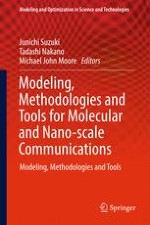2017 | OriginalPaper | Chapter
Quantifying Robustness in Biological Networks Using NS-2
Authors : Bhanu K. Kamapantula, Ahmed F. Abdelzaher, Michael Mayo, Edward J. Perkins, Sajal K. Das, Preetam Ghosh
Published in: Modeling, Methodologies and Tools for Molecular and Nano-scale Communications
Publisher: Springer International Publishing
Activate our intelligent search to find suitable subject content or patents.
Select sections of text to find matching patents with Artificial Intelligence. powered by
Select sections of text to find additional relevant content using AI-assisted search. powered by
